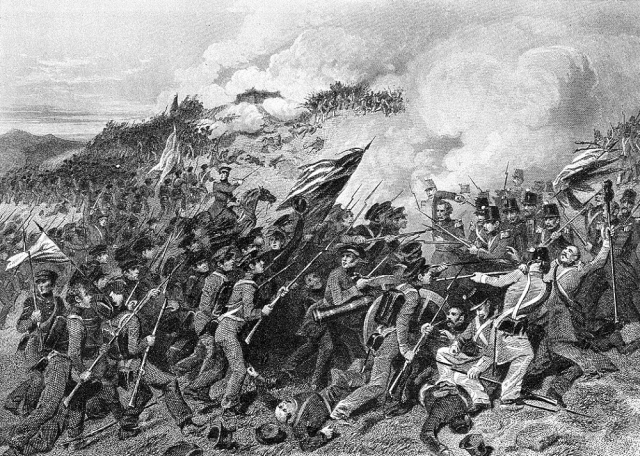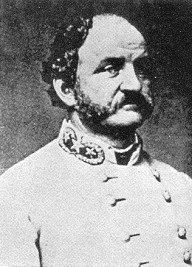Kentucky's Mexican War Trophy
The story of "Old Long Tom" Kentucky’s Mexican War Trophy is an interesting one, which has never been fully told. What happened to "Tom" after "he" was removed from the State Arsenal by Confederate forces is a mystery waiting to be discovered.
"Tom" is well documented in books, quartermaster records, newspaper accounts and even Kentucky Resolutions.

6th U.S. Infantry at the Battle of Cerro Gordo
"Tom" was a cannon, a war trophy of the Mexican War. "He" was described as an unmounted Mexican six-pounder, bearing the date 1773, with a barrel length of ten to twelve feet. Midway of its length, were two hand-holds, or loops, on each side, used to lift the gun with a hoisting machine. During the Mexican War, Captain John Stuart Williams organized and commanded the Clark County Kentucky volunteers. It was an independent company, attached to the 6th U.S. Infantry at the Battle of Cerro Gordo. Williams’ conduct during the battle won him the sobriquet "Cerro Gordo" Williams, which he was afterwards known. He later served as colonel of the 4th Kentucky Volunteers during the latter part of the War.
In his official report of the Battle of Cerro Gordo, to Secretary of War William L. Marcy, dated April 19, 1847, Major General Winfield Scott made the following comments concerning captured artillery pieces.

Captain "Cerro Gordo" Williams
Sir: — The plan of attack, sketched in General Orders, No. 111, forwarded herewith, was finely executed by this gallant army, before two o’clock P.M. yesterday. We are quite embarrassed with the results of victory – prisoners of war, heavy ordnance. Field batteries, small arms, and accoutrements.. . . . I am, also, somewhat embarrassed with the – pieces of artillery, all bronze, which we have captured. It would take a brigade, and half the mules of our army, to transport them fifty miles. . . . . A field battery I shall take for service with the army; but the heavy metal must be collected, and left here for the present.
Out of these spoils of war came Kentucky’s Mexican War Trophy, "Old Long Tom"
Military History of Kentucky, page 135.. . . . Captain Williams’ company reached Louisville about two weeks later, bringing with it a brass six-pounder captured at Cerro Gordo.
Article from the Observer & Reporter, Lexington, Kentucky, Wednesday, June 9, 1847. Captain Williams we see, brought with him a Mexican six-pounder, bearing the date of 1773, and two large bomb shells, thirteen inches in diameter and two and a quarter inches thick. The gun was taken by his company in the battle (Cerro Gordo). He intends to present his trophies to the State.
Article from the Observer & Reporter, Lexington, Kentucky, Wednesday, June 24, 1847. We can not better make the correction of the error into which we were led in speaking of the trophies brought by the Clarke volunteers from Mexico, than by the publication of the following note to us from Capt. Williams; Winchester, June 19, 1847. Mr. Editor: — I regret that, in the Observer & Reporter of the 9th inst., in mentioning the brass six pounder, which I brought from Cerro Gordo to Kentucky, you have been led into the error of saying, that "it was taken by my company." This gun was not taken by my company; it belonged to one of the batteries upon the right of the enemy’s line, and fell into the hands of the American army upon Gen. La Vega’s surrender. Please make the corrections and oblige.
Yours, respectfully,
Jno. S. Williams.
On July 27, 1847, the burial of the remains of Kentuckians who were killed at the battle of Buena Vista, took place at the Frankfort Cemetery. The cannon taken at Cerro Gordo had been mounted for the occasion, and shrouded in crepe. The cannon was part of the funeral march from the (Old) State Capitol to the cemetery.
Kentucky Resolutions of 1848. Resolution number 16, approved March 1, 1848. Resolutions in relation to the two Cannons presented to the State of Kentucky by Major Geo. A. Caldwell and Col. John S. Williams.
Resolved by the General Assembly of the Commonwealth of Kentucky, That the cannon tendered by Maj. Geo. A. Caldwell and Col. John S. Williams, be accepted, and that the Governor cause to be inscribed thereon, respectively, the history of their capture and the names of the donors. Resolved further, That the Governor communicate to those distinguished officers (now in Mexico,) copies of these resolutions, and tender to them the thanks of Kentucky, for those valuable trophies of the valor of our countrymen at the memorable battle of Cerro Gordo.
Report, Quartermaster General for the State of Kentucky, Frankfort Arsenal, December 1, 1859. Under the heading "Ordnance and Stores, Arms and Equipment in the State Arsenal," is a listing of 2 brass 6-pounders, Mexican, in bad order. The last paragraph of the report is the following statement concerning the Mexican cannon: "I would also call your attention to a piece of brass ordnance taken in the late war with Mexico, and presented to the State of Kentucky. These pieces are unmounted; and if they were properly mounted, they would add greatly to the ordnance department."
During the Civil War Confederate forces captured the city of Frankfort in August 1862. The Confederates controlled the city for approximately one month, during which time they removed weapons and equipment from the State Arsenal. Letter, Quartermaster General for the State of Kentucky, Frankfort Arsenal, no date. Property Captured from Arsenal 2 Brass 6 pdr. Cannon, not mounted.
Fate of "Old Long Tom" Remains Unsolved
When the Confederate army under General Braxton Bragg retreated from the State and evacuated this city they carried that relic of the battle of Cero Gordo with them. Col. Williams, whose command captured it afterward became a General in the Confederate Army, and for years after the Mexican War was known to the politicians of the State as Cero Gordo Williams.
Article from The State Journal, Frankfort, Kentucky, Sunday morning, May 29, 1927. It was there that the old long Mexican cannon which was fired by Dick Tate and John Crutcher, was mounted and stood just inside the door until it was carried away by the Confederates in the fall of 1862.
What did the Confederates do with "Tom"?
Had they already moved "him" from the Arsenal prior to their hasty retreat out of Frankfort in October 1862?
Large and heavy, and as far as records indicate, unmounted, would they have just "dumped" "him" somewhere?
Or, did they mount "him" making "him" a functional piece of artillery once again, for use in one of the battles of the Civil War?
Will we ever know what happened to Kentucky’s Mexican War Trophy, "Old Long Tom"?